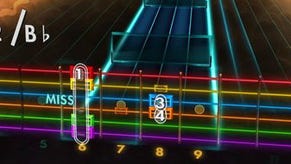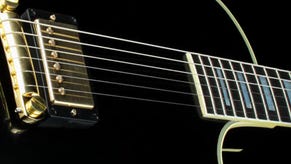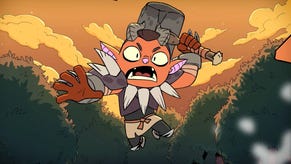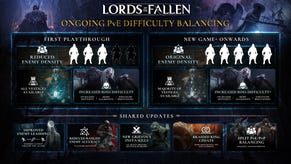Rocksmith 2014: can it help a guitar noob become a guitar hero?
Rocksmith 2014 is coined as a learning tool for fledgling guitar players. Newcomer Ray Willmot takes axe in hand and plays for a few weeks to see if it really can give him the skills to pay the bills.
Prior to Rocksmith 2014, the extent of my guitar-playing abilities saw me struggling to get through Hard on Through the Fire & the Flames on Guitar Hero 3. Somehow, I reached the mid point of the song, and despite having just under a 50% accuracy rating, I considered that an accomplishment.
Enthusiasm has never been an issue. As far back as I can remember, I’ve always had an obsession with riffs and chords, but comparing a six-string to a lever of plastic is as ludicrous as it sounds. But when I finally got a Les Paul 2 in my hands, I was ready to up my game.
Inspired by the solos of Dimebag Darrel, Kirk Hammett, Robb Flynn and Randy Rhoads, I promised myself, from this moment on, I’m going to get decent and learn how to handle this properly, and while Rocksmith 2014 hasn’t made me a professional yet, I’m a much better player than I ever would have been if I’d relied on anything else or tried to do this by myself.
The game’s video-lessons are a fantastic barrier for entry. Treating myself as a complete novice, I experienced them all and was soon taught how to hold my guitar, using a pick to strum, tuning the guitar and how to slide down frets. The game even goes into detail about those small dots along the neck of the instrument. There’s even a finger positioning tool.
Rocksmith 2014 is a patient tutor. The game never criticises, only encourages, and there were many occasions during tutorials where I got stuck. The game requires absolute precision in order for you to proceed past certain sections; however, it will continuously restart that section without a snarky comment or thinly-veiled insult. After several hours of watching videos and honing my technique, I was itching to get rocking.
Fortunately for me, the tuition definitely paid off. Coupled with my Guitar Hero experience, I chose to 'Learn a Song' and dived right into Knights of Cydonia by Muse. It’s a favourite of mine and a tune I’m familiar playing on Guitar Hero. So I’m going to ace it, right?
Much to my surprise, I only managed to complete the song to 40%. Each song starts the player off lightly, giving them a few notes to make up the core foundation of the tune. But as you continue playing and hitting those notes and mastering the techniques, Rocksmith keeps throwing in more notes, until eventually you’re playing the song in its entirety.
I started out on a medium, though you can set the difficulty prior to starting the song, a new addition from last year’s edition. You can even set the difficulty for specific parts of a song, meaning certain sections can be made much easier or harder, depending on your skill level.
”Rocksmith 2014 is a revolutionary piece of software that proves interactive experiences can educate and entertain. In an age where sceptics and critics are eager to see video games abolished, it comes out with a point to prove.”
Unfortunately, I hit a proverbial brick wall when an abundance of notes suddenly started to pop up, where trying to shift between chords accelerated out of my control. It’s all well and good being able to press a few multicoloured buttons, but adapting that knowledge to strings is a whole other playing field.
Post-play, Rocksmith assesses overall performance, then suggests specific missions for the player to try in order to get them towards that elusive 100%. Rocksmith 2014 offers new features, such as Automatic Tone Switching, Articulation Timing and the Instant Riff Repeater. The Riff Repeater places the player at a particular point in the song and allows them to replay that section to their heart’s content. This was useful for me switching between frets in the song, and helped me acclimatise quicker than if I’d had to keep restarting the song from the beginning.
Unfortunately, I still wasn’t quite dexterous enough to get everything completely mastered. I needed a way to build up my reactions and improve my reflexes. That’s where the Guitarcade comes in. The Guitarcade will devour your free-time. You’ll actually want to stay there, mastering these silly little games, putting in a better performance than your friends just to move up the leaderboards.
Guitarcade games will improve your reactions in fun, simplistic ways. For instance, Ninja Slide N, tasks the player with sliding down a certain number of frets in order to jump between towers. Another game requires you to play chords to shoot at ducks.
All of these games speed up over time and continually mount pressure on the player, naturally affecting performance. The change in pace familiarised me with all aspects of playing the guitar very quickly. I didn’t have to keep looking at my left hand to see which position my hand was in. I was aware of where I needed my hand to be placed in order to play a specific note. My muscle memory was working overtime.
These diversionary games can actually teach you more about playing the guitar than some of the actual lessons because you don’t have time to think about how to control the action, but you need to be accurate and you’ll want to keep playing to improve on your previous high score. The Guitarcade games also improves awareness, as well as speed. Using the Guitarcade effectively along with the lessons, will make you feel much more comfortable when going out to tackle a song.
The experience certainly helped me. Heading right back into Knights of Cydonia, I stormed my way to 61% completion, with only my technique left to be refined. When finished, Rocksmith presents a results screen displaying your in-song performance. This shows the percentage of the song you nailed and the sections that you didn’t. From this, Rocksmith then tries to think of ways you can improve, offering further advice and guidance.
Unfortunately, Rocksmith really had nothing left for me, other than to keep practicing on the things I had already worked on, and when those skills didn’t naturally come to me, I decided to blow off some steam in the game’s fantastic Session Mode. It puts you in charge of an AI-controlled band made up of a variety of instruments: from drums to a kazoo. The mode is designed to let you improvise.
The AI is your best kind of partner in this jam session. If you’re really shredding licks with the guitar, it will pick up the pace and get loud. Likewise, if you’re playing softly, the AI will play at a much lighter tempo.
It’s an extremely dynamic, reactive experience that presents an amazing local opportunity for creating music with a friend, or just seeing what comes out of various different instrumental combinations. It’s also a great way to get familiar with an instrument without pre-defined set conditions or lessons attached. You can just play and make music with no embellishments.
Rocksmith 2014 is a revolutionary piece of software that proves interactive experiences can educate and entertain. In an age where sceptics and critics are eager to see video games abolished, it comes out with a point to prove.
I’m still learning, but I’ve definitely become much more comfortable with the instrument. I can string together recognisable chords from classic songs, have a better understanding of how everything works and developed a greater respect for the musicians who make a living from this craft.
Rocksmith 2014 has become a part of my daily routine and I love that. I can’t wait to see what kind of player the game can turn me into over the next twelve months.










.png?width=291&height=164&fit=crop&quality=80&format=jpg&auto=webp)






